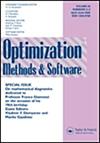User'S guide To Lipsol linear-programming interior point solvers V0.4
IF 1.4
3区 数学
Q3 COMPUTER SCIENCE, SOFTWARE ENGINEERING
引用次数: 42
Abstract
LIPSOL stands for Linear programming Interior-Point SOLvers. It is a free, Matlab-based software package for solving linear programs by interior-Point methods. It requires Matlab version 4.0 or later to run. The current release of LIPSOL is for 32-bit UNIX platforms. LIPSOL is designed to solve relatively large problems. It utilizes Matlab’s sparse-matrix data-structure and Application Program Interface facility, and at the same time takes advantages of existing, efficient Fortran codes for solving large, sparse, symmetric positive definite linear systems. Specifically, LIPSOL constructs MEX-files from two Fortran packages: a sparse Cholesky factorization package developed by Esmond Ng and Barry Peyton at ORNL and a multiple minimum-degree ordering package by Joseph Liu at University of Waterloo . Built in the high-level programming environment of Matlab, LIPSOL enjoys a much greater degree of simplicity and versatility than codes in Fortran or C language. On the other hand, utilizing efficient Fortran codes for computationally intensive tasks, LIPSOL also has adequate speed for solving moderately large-scale problems even in the presence of overheadLipsol线性规划内部点求解器V0.4的用户指南
LIPSOL代表线性规划内点求解器。它是一个免费的,基于matlab的软件包,用于用内点法求解线性程序。需要Matlab 4.0或更高版本才能运行。LIPSOL的当前版本适用于32位UNIX平台。LIPSOL设计用于解决相对较大的问题。它利用Matlab的稀疏矩阵数据结构和应用程序接口功能,同时利用现有的高效Fortran代码来求解大型、稀疏、对称的正定线性系统。具体来说,LIPSOL从两个Fortran包构建了x - x文件:一个是由ORNL的Esmond Ng和Barry Peyton开发的稀疏Cholesky分解包,另一个是由滑铁卢大学的Joseph Liu开发的多个最小度排序包。LIPSOL内置在Matlab的高级编程环境中,与Fortran或C语言的代码相比,它具有更大程度的简单性和通用性。另一方面,利用高效的Fortran代码进行计算密集型任务,LIPSOL即使在存在开销的情况下也有足够的速度来解决中等规模的问题
本文章由计算机程序翻译,如有差异,请以英文原文为准。
求助全文
约1分钟内获得全文
求助全文
来源期刊

Optimization Methods & Software
工程技术-计算机:软件工程
CiteScore
4.50
自引率
0.00%
发文量
40
审稿时长
7 months
期刊介绍:
Optimization Methods and Software
publishes refereed papers on the latest developments in the theory and realization of optimization methods, with particular emphasis on the interface between software development and algorithm design.
Topics include:
Theory, implementation and performance evaluation of algorithms and computer codes for linear, nonlinear, discrete, stochastic optimization and optimal control. This includes in particular conic, semi-definite, mixed integer, network, non-smooth, multi-objective and global optimization by deterministic or nondeterministic algorithms.
Algorithms and software for complementarity, variational inequalities and equilibrium problems, and also for solving inverse problems, systems of nonlinear equations and the numerical study of parameter dependent operators.
Various aspects of efficient and user-friendly implementations: e.g. automatic differentiation, massively parallel optimization, distributed computing, on-line algorithms, error sensitivity and validity analysis, problem scaling, stopping criteria and symbolic numeric interfaces.
Theoretical studies with clear potential for applications and successful applications of specially adapted optimization methods and software to fields like engineering, machine learning, data mining, economics, finance, biology, or medicine. These submissions should not consist solely of the straightforward use of standard optimization techniques.
 求助内容:
求助内容: 应助结果提醒方式:
应助结果提醒方式:


